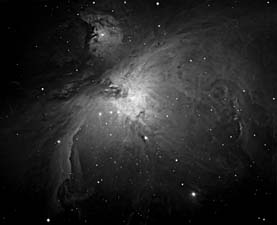Return to Index |
Previous Image |
Next Image |
The Orion nebula
is a stellar nursery, filled with young stars and gas. 1,500 light years
away, it is the closest region of its type to the Earth. Orion is an emission
nebula, meaning that it is many light years across and very large in comparison
to other types of nebulae. Located in the middle of Orion the Hunter's
sword, the Orion nebula is actually part of a much larger cloud of gas
and dust that covers a majority of the Orion constellation. The giant
gas cloud is illuminated by the young hot stars it produces. Many of the
stars that appear fainter are encapsulated by disks of gas and dust. The
diagonal length of the region is roughly 1.6 light years. The Orion nebula
is one of the brightest Deep Sky objects, easily visible with the human
eye in the night sky. Interstellar extinction alters the optical appearance
of the Orion Nebula. This means that many regions are obscured by dust
clouds. Since the Orion Nebula is well above the Galactic plane, most
of the extinction is caused by the star cluster located directly in front
of the nebula. The extinction can be quantitatively studied by measuring
the hydrogen emission associated with the region. One feature of the extinction
is a dark bay that covers the east side of the nebula. It has a mass about
three times that of the Sun and contains a number of small knots of material.
There is a thin emitting layer on the front of the associated Orion molecular
cloud that is covered with "walls" and "plateaus." Many of the features
obscured in the optical wavelengths can be easily viewed at other wavelengths,
where the dust clouds become transparent. Radio image of the same region
can also be seen with no obscuration by dust clouds. Note that the radio
image does not show any radio emission from stars. (Copyright Anglo-Australian Observatory)
References:
http://oposite.stsci.edu/pubinfo/gif/OrionFull.txt
http://seds.lpl.arizona.edu:80/billa/twn/n1976x.html
Object |
Distance from Earth |
Wavelength |
Orion
Nebula |
1,500
light years |
Optical |

